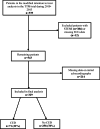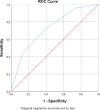External validation of the CREST model to predict early circulatory-etiology death after out-of-hospital cardiac arrest without initial ST-segment elevation myocardial infarction
- PMID: 37340361
- PMCID: PMC10283318
- DOI: 10.1186/s12872-023-03334-4
External validation of the CREST model to predict early circulatory-etiology death after out-of-hospital cardiac arrest without initial ST-segment elevation myocardial infarction
Abstract
Background: The CREST model is a prediction model, quantitating the risk of circulatory-etiology death (CED) after cardiac arrest based on variables available at hospital admission, and intend to guide the triage of comatose patients without ST-segment-elevation myocardial infarction after successful cardiopulmonary resuscitation. This study assessed performance of the CREST model in the Target Temperature Management (TTM) trial cohort.
Methods: We retrospectively analyzed data from resuscitated out-of-hospital cardiac arrest (OHCA) patients in the TTM-trial. Demographics, clinical characteristics, and CREST variables (history of coronary artery disease, initial heart rhythm, initial ejection fraction, shock at admission and ischemic time > 25 min) were assessed in univariate and multivariable analysis. The primary outcome was CED. The discriminatory power of the logistic regression model was assessed using the C-statistic and goodness of fit was tested according to Hosmer-Lemeshow.
Results: Among 329 patients eligible for final analysis, 71 (22%) had CED. History of ischemic heart disease, previous arrhythmia, older age, initial non-shockable rhythm, shock at admission, ischemic time > 25 min and severe left ventricular dysfunction were variables associated with CED in univariate analysis. CREST variables were entered into a logistic regression model and the area under the curve for the model was 0.73 with adequate calibration according to Hosmer-Lemeshow test (p = 0.602).
Conclusions: The CREST model had good validity and a discrimination capability for predicting circulatory-etiology death after resuscitation from cardiac arrest without ST-segment elevation myocardial infarction. Application of this model could help to triage high-risk patients for transfer to specialized cardiac centers.
Keywords: Cardiac arrest; Prediction model; Resuscitation.
© 2023. The Author(s).
Conflict of interest statement
The authors declare no competing interests.
Figures



Similar articles
-
Derivation and Validation of the CREST Model for Very Early Prediction of Circulatory Etiology Death in Patients Without ST-Segment-Elevation Myocardial Infarction After Cardiac Arrest.Circulation. 2018 Jan 16;137(3):273-282. doi: 10.1161/CIRCULATIONAHA.116.024332. Epub 2017 Oct 26. Circulation. 2018. PMID: 29074504
-
Validation of the CREST model and comparison with SCAI shock classification for the prediction of circulatory death in resuscitated out-of-hospital cardiac arrest.Eur Heart J Acute Cardiovasc Care. 2024 Aug 28;13(8):605-614. doi: 10.1093/ehjacc/zuae070. Eur Heart J Acute Cardiovasc Care. 2024. PMID: 38805012
-
Validation of the CREST score for predicting circulatory-aetiology death in out-of-hospital cardiac arrest without STEMI.Am J Cardiovasc Dis. 2021 Dec 15;11(6):723-733. eCollection 2021. Am J Cardiovasc Dis. 2021. PMID: 35116185 Free PMC article.
-
Indications for Cardiac Catheterization and Percutaneous Coronary Intervention in Patients with Resuscitated Out-of-Hospital Cardiac Arrest.Curr Cardiol Rep. 2023 Nov;25(11):1523-1533. doi: 10.1007/s11886-023-01980-w. Epub 2023 Oct 24. Curr Cardiol Rep. 2023. PMID: 37874467 Review.
-
Coronary angiography and percutaneous coronary intervention in cardiac arrest survivors with non-shockable rhythms and no STEMI: A systematic review.Resuscitation. 2019 Oct;143:106-113. doi: 10.1016/j.resuscitation.2019.08.023. Epub 2019 Aug 21. Resuscitation. 2019. PMID: 31442472
References
-
- Gräsner JT, Lefering R, Koster RW, Masterson S, Böttiger BW, Herlitz J, et al. EuReCa ONE-27 nations, ONE Europe, ONE Registry: a prospective one month analysis of out-of-hospital cardiac arrest outcomes in 27 countries in Europe. Resuscitation. 2016;105:188–95. doi: 10.1016/j.resuscitation.2016.06.004. - DOI - PubMed
-
- McNally B, Robb R, Mehta M, Vellano K, Valderrama AL, Yoon PW, et al. Out-of-hospital cardiac arrest surveillance --- Cardiac arrest Registry to enhance survival (CARES), United States, October 1, 2005–December 31, 2010. Morbidity and mortality weekly report Surveillance summaries (Washington DC: 2002) 2011;60(8):1–19. - PubMed
Publication types
MeSH terms
LinkOut - more resources
Full Text Sources
Medical

